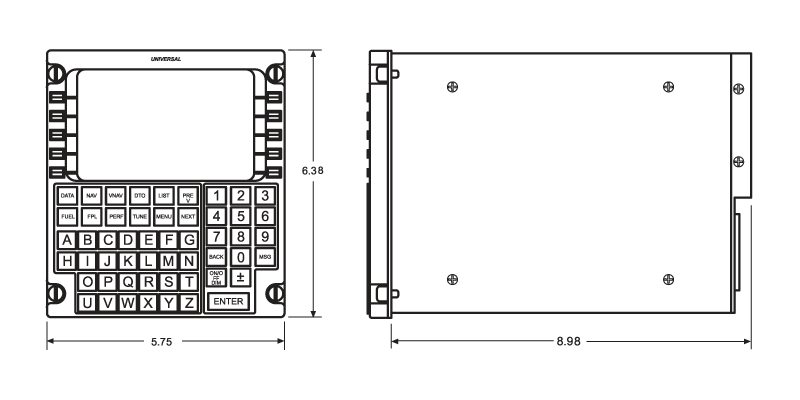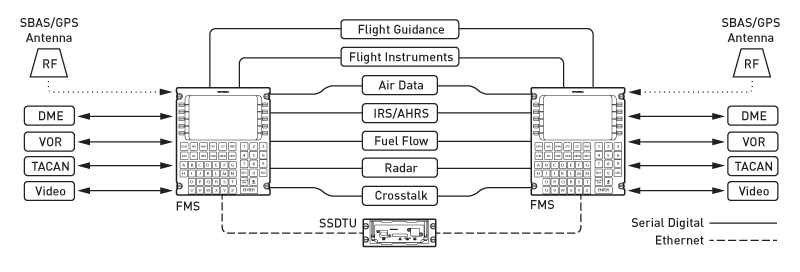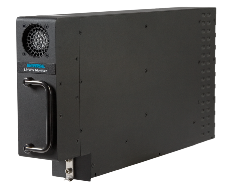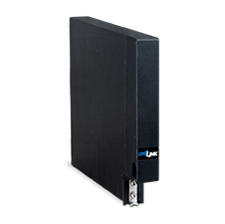The UNS-1Ew features a self-contained design which includes control/display functions and the Navigation Computer Unit (NCU) with an integrated GPS/SBAS receiver. The system includes a graphics- and video-capable 5-inch diagonal display
with a housing depth of approximately 9 inches.
A special package version, the UNS-1Espw has a reduced depth and includes the same features with the exception that it is an all-digital system only. The UNS-1Espw is ideal for applications where console or panel depth pose an integration
challenge. Analog Roll steering and discretes are included with the UNS-1Espw.
Universal Flight Management Systems (FMS) offer the quickest, most efficient means of creating a flight plan and a pilot-friendly approach to altering plans.
Information is at your fingertips, including real-time fuel management to eliminate unnecessary fuel stops, saving time and money. Fly complex procedures accurately with enroute navigation for holding patterns, approaches, heading to altitude and more. Access extensive navigation databases with quick and efficient ways to enter data.
FMS's build upon the company's popular market proven product design, offering more advanced features and interfaces, and a growth path to meet the requirements of the future.
Flight Planning
FMS Flight Planning
The Flight Planning (FPL) function provides you with the quickest, most efficient means of creating a flight plan, and the most pilot-friendly method of altering the flight plan elements as desired or required by ATC. It has been engineered to incorporate
the greatest level of safety, with numerous built-in safeguards such as the entry of list-referenced selections which reduce both keystrokes and errors.
Off-Line Flight Planning
The Universal Flight Planning (UFP) Windows based software provides you with off-line flight planning, GPS Fault Detection, and Exclusion prediction capabilities. Learn more and download the Universal Flight Planning (UFP) Program.
Performance
The UNS-1Ew and UNS-1Fw SBAS-FMSs provide a Performance (PERF) option for select aircraft types for which performance charts from the Airplane Flight Manual (AFM) are digitized and stored in memory. These FMSs will use pertinent data such as GW, ALT,
OAT, etc., to provide exact values for V1, VR and V2, along with Takeoff N1.
Fuel Management
Using inputs from the fuel flow sensors, the SBAS-FMS provides real-time fuel management with the most extensive fuel information and calculations available – the kind that can eliminate unnecessary fuel stops, save you time and money and provide
increased safety. Specific range and endurance are provided along with fuel, time and distance predictions for your destination.
Lists
The unique LIST function provides a quick and efficient means to access and enter data, minimizing alphanumeric entries and reducing input errors. The “smart” lists are geographically prioritized based on aircraft position and course, then
alphabetized on each page. You can quickly enter airports, navaids, intersections and airways all by simply entering the list reference number corresponding to the data desired.
Data Management
The DATA function key provides access to a variety of navigation data management capabilities. Easy access to your stored navigation database for detailed review of SIDs, STARs, approaches, runways, airways, intersections, navaids and airports. Your pilot-defined
database can be accessed and edited, allowing you to create new or modify your pre-defined departures, arrivals, approaches, runways, airports, waypoints, alignment points and stored routes. Your non-editable company route database can be accessed
as well.
Enroute
Navigation
The SBAS-FMS will fly all procedural leg types in accordance with ARINC 424. This sophisticated capability allows you to fly the most complex procedures such as heading to altitude, precision arc, procedure turn, holding pattern and more – all the
necessary maneuvers required to accurately fly SIDs, STARs and approaches.
Direct-To
The Direct-To (DTO) function key is specifically dedicated for flight plan changes in response to “Direct-To” clearances. The SBAS-FMS easily takes you from your present position direct to any point on or off your flight plan using circular
arc steering. If the desired waypoint is on the flight plan, it may be selected by entering its list reference number. If the desired waypoint is not on the flight plan, the LIST function can be used to access other waypoints/airports within the surrounding
area from the database, or the identifier can be manually entered into the field.
Vertical Navigation
Universal Avionics’ SBAS-FMSs incorporate the most advanced concepts in vertical guidance and control. VNAV pages provide for such features as computed Top-Of-Descent, Target Vertical Speed indication and selection, and Vertical Direct-To commands.
Vertical waypoints can be conveniently defined with altitudes or Flight Levels, and lateral offsets.
Frequency Management
Frequency management capabilities allow you to tune your NAV and COMM radios through the SBASFMS – completely interfaced with your existing Radio Management Unit. The SBAS-FMS presents a list of suggested COMM, Nav and NDB frequencies pre-selected
based on aircraft position and phase of flight. Additionally, you can customize the radios tuned through the SBAS-FMS by storing an “active” and up to four “preselect” frequencies. A “recall” feature allows you
to swap the active with the last frequency tuned without affecting the preselect frequencies.
Messages
An extensive library of messages has been programmed into the SBAS-FMS. The message annunciator alerts you of system status advisories, including way- point alerts, sensor watchdog functions, and self-test. “Pop-up” messages in response to
invalid entries further simplify system operation. The Message (MSG) key may also be used to access datalink communications should this optional equipment be installed.
Holding Patterns
Holding patterns are accurately flown through the SBAS-FMS automatically, complete with appropriate entry procedure: direct, parallel or teardrop. The navigation database includes holding patterns that are part of departure, arrival, approach and missed
approach procedures. The aircraft will fly the normal flight plan legs and then automatically enter the holding pattern upon reaching the holding fix. You may also manually define a holding pattern by specifying the holding fix, inbound course, turn
direction and either time or distance of holding leg. When armed, the holding pattern will be entered automatically upon reaching the fix. A DTO HOLD command is also provided to enable you to go direct to a holding fix at any time.
Approaches
Approach
Once near your destination, you can easily link the appropriate approach for the active runway into your flight plan. Approaches and runways from the navigation database, and those which have been pilot defined, are easily accessed.








